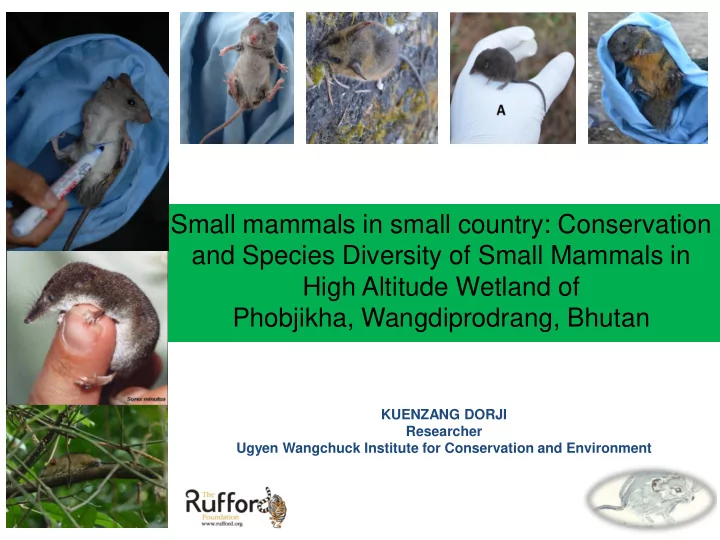

Small mammals in small country: Conservation and Species Diversity of Small Mammals in High Altitude Wetland of Phobjikha, Wangdiprodrang, Bhutan KUENZANG DORJI Researcher Ugyen Wangchuck Institute for Conservation and Environment
Presentation Outline • Introduction – Problem Statement – Objectives • Materials and Methods – Study area – Research Design – Data collection – Materials used – Data Analysis • Results • Conclusion • Recommendation • Acknowledgement 2
Introduction • Small mammals are animal which weighs less than 500 g and are terrestrial and arboreal in nature (Anke et al., 2010). • Small mammals have highest diversity comprising of 3821 species(ibid). • Wetlands supports high small mammals communities and represent area of considerable conservation importance (Erasmus, 1992). 3
Problem Statement • Lack of vital information on their distribution, abundance and population trends. • Royal Society for Protection of Nature’s management plan to conserve wintering habitat of Black Necked Crane lacks information on diversity of small mammals. 4
Research Objectives • To estimate the species diversity of terrestrial small mammals with relation to habitat types in high altitude wetland of Phobjikha. • To assess the affect of environmental variables on presence of small mammals in high altitude wetland of Phobjikha. • To identify the conservation threats that affects the survival of small mammals in high altitude wetland of Phobjikha. 5
Materials and Methods: Study Area Phobjikha Conservation Area ( PCA)- 162 Sq.Km. 4 major ecosystems : • Forests, • Grassland, • River and • Agro Table 1. Area of land under major habitat types Habitat Types Area (km²) 101.67 Forest Open Grass Land 45.4 Agricultural Land 9.44 5.49 Riparian Figure 1 . A) Location of Wangdiprodrang District and Phobjikha Conservation Area. 162 Total B) Four habitat types of study site (PCA) 6
Research Design G A C E D F B Figure 2 . A. Riparian; B. Forest; C. Open Grass; D. Agriculture land; E. Sherman traps; F. Pitfall trap and 7 G. Stratified Habitat
Data Collection • Species, sex, weight and length. A B • Slope, aspect, canopy cover, undergrowth and ground cover, soil PH, microhabitat sites • Anthropogenic activities- grazing, road, timber extraction, stone/boulder collection and fire Figure 3 : A. Sexing the animal; B. Weighing, C. measuring tail length and D. Transferring animal to handling bag C D 8
Materials Used E F A G H I A B L J K C M D Figure 4 : A. Sherman traps; B. Pitfall traps; C. Ruler; D. Pesola Spring; E. GPS; F. Measuring tape; G. Ribbon; H. Compass; I. Datasheet; J. Gloves; K. Clinometer; L. Scoops; and M. Crowbar 9
Animal Baits A B C D E G G F Figure 5 : A. Oats, B. Peanut Butter, C. Can fish, D. Apple, E. Carrot, F. Biscuits and G. Flour 10
Safety Equipments C B A D Figure 6 : A. Hand sanitizer, B. Gloves, C. Soap, and D. Mask 11
Data Analysis • Shannon Diversity Index (H’) – Species Evenness (J) – Species Richness = S-1/LogN – Relative abundance= Statistical Tests. • One sample T test • Chi square test Figure 7 . A. Orienting the transect line direction; B. Measuring distance between traps; C. Taking morphometric measurement and D. Setting traps in snow ( forest habitats) 12
Results- Animal Captured C B A D E F G Figure 8 : A. Rattus rattus, B. Niviventer eha, C. Macrotus sikimensis, D. Sorex minutus, E. Dremomys lokriah, F. Ochotona macrotis and G. Niviventer neviventer 13
Results- Species Diversity 7 Species diversity, richness and evenness 6 5 Eveness 4 Diversity 3 Richness 2 1 0 Forest Agriculture Open Grass Riparain Habitat Types Figure 9 : Species diversity, richness and evenness of small mammals in PCA 14
Results- Small mammals in relation to aspect and slope Table 2. Number of small mammals in different slopes in percent. Slope Category Moderate ( 16 ° - Steep ( 31 ° and Gentle ( 0 ° -15 ° ) 30 ° ) above) Total Orders Insectivora 66 12 1 79 Lagomorpha 1 0 0 1 Rodents 42 5 1 48 Total 109 19 2 128 Percent 85.16% 14.84% 1.56% Figure 10 : The response of small mammals to aspects BSc Sustainable Development 15
Results- Conservation Threats B A 80 70 60 No. of animals 50 40 30 20 10 0 Low Medium High Degree of Disturbance Figure 11 . A) Types of anthropogenic threats. B. The intensity of the disturbance 16
Conclusion • The species diversity and relative abundance of small mammals were comparatively high in forests and agricultural land. • The number of small mammals was related to habitat types, slope gradient, aspect and microhabitats. • Small mammals positively responded to anthropogenic threats with high intensity of disturbance. 17
Recommendation • Study covering other two seasons is recommended to ascertain the comprehensive list of small mammals of Phobjikha valley. • Unplanned extraction of timber and plying of tractor inside the forest freely should be strictly monitored. 18
Acknowledgement Highly indebted to: • Dr Om Katel for unconditional guidance and support. • Dr. Ellen Cheng, Dr Kerry Foresman, University of Montana, US and Dr. Andras Darabant, Project Scientist, Boku University for technical help in proposal and data analysis • Director and CRE, UWICE for equipments. • The Rufford Foundation for financial support • Field assistants Mr. Sonam Choenjur, Tandin Dorji, Phuntsho and Rinchen (JSWNP) for their assistance in data collection • Family members for their love, support and understandings. • Course mates for both conditional and unconditional support and help. 19
Tashi- Delek
Recommend
More recommend